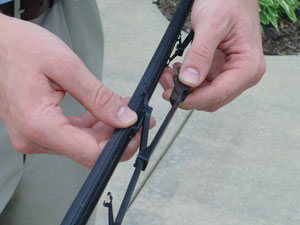Read up on essential products in our annual technical sales seminar section. We review 12 products you need to know better to move products.
Brakes
Fuel Pumps
Gaskets
Batteries
Wipers
Catalytic Converters
Shocks
Engine Management
Lighting
Belts and Hoses
Oxygen Sensors
Antifreeze
Wiper blades are a product that every vehicle needs, yet the wipers on many vehicles are in poor condition and are long overdue for replacement. Good wipers that wipe cleanly without streaking or skipping are absolutely essential for safe driving during wet weather. If the driver’s vision is obscured by water, sleet or snow on the windshield, they may not be able to react quickly enough to other vehicles, obstacles, pedestrians or animals in the road ahead. Dirt, road splash and bug splatter on the windshield can also interfere with good vision. If the wipers cannot remove this gunk without leaving a smeared mess, they aren’t doing their job.
 Most wiper blades are either natural rubber or synthetic rubber, which means they have a limited service life (and shelf life). Sunlight and atmospheric ozone age the rubber, causing it to harden and crack. As a rule, most wiper blades should be replaced yearly — or with every third or fourth oil change depending on how many miles the vehicle is driven and how often the oil is changed. The longevity of the wipers can vary depending on environmental exposure and use. A vehicle that is parked outdoors in direct sunlight, especially in a hot climate, will probably need new blades every six months — even if the wipers are seldom used. By comparison, the wipers on a vehicle that is stored indoors may last much longer even in a wet climate.
Most wiper blades are either natural rubber or synthetic rubber, which means they have a limited service life (and shelf life). Sunlight and atmospheric ozone age the rubber, causing it to harden and crack. As a rule, most wiper blades should be replaced yearly — or with every third or fourth oil change depending on how many miles the vehicle is driven and how often the oil is changed. The longevity of the wipers can vary depending on environmental exposure and use. A vehicle that is parked outdoors in direct sunlight, especially in a hot climate, will probably need new blades every six months — even if the wipers are seldom used. By comparison, the wipers on a vehicle that is stored indoors may last much longer even in a wet climate.
Wipers that are chattering and noisy or not wiping cleanly need to be replaced regardless of their age. Conventional blades with metal frames that are torn or falling apart should be replaced without delay to prevent permanently scratching the windshield.
Wiper problems also can be caused by a loss of spring tension in the wiper arms. The springs inside the wiper arms can weaken with age, and the hinge point on the wiper arm may become stiff and bind from corrosion. Lubricating the hinge point may restore normal operation, but if the spring is weak or broken the arm must be replaced.
Wiper arm spring tension can be checked with a pull gauge (like a fish scale). New arms with conventional frame style blades typically have a spring tension of around 14 Newton-meters (10.3 lbs.) while the tension on newer vehicles with flat frameless blades is typically around 17 N.m (12.5 lbs.). Tension will vary somewhat by application, the length of the arms and the size of the blades.
This difference in tension can sometimes cause problems when a customer is upgrading from conventional wipers to the new flat style frameless blades. If the arms do not generate enough down force, the new blades may not perform properly or fail to conform well to a highly curved windshield. The customer usually blames the blades, but the problem is actually the weak wiper arms.
Of course, not all wiper blades are the same. Some are made with better materials and some manufacturers do more testing to assure a given part number conforms to all the applications is is supposed to fit.
Wiper blades are typically sold by length, but this is not always the most accurate way to determine a correct replacement blade. The passenger or driver side blade may have to conform to greater curvature than the other, so some blades that are the same length may have a different part number for one side of the vehicle or the other. The best advice is to follow the application listings by the wiper supplier.
Many vehicles have asymmetrical length wiper blades. The wiper on the driver’s side is often longer than the passenger side wiper. A blade that is too long for either side may hit the edge of the windshield, the cowl or the other wiper blade. Or, it may fail to wipe cleanly due to reduced pressure along the length of the blade. A blade that is too short may leave gaps or not wipe the full area, impeding visibility.











